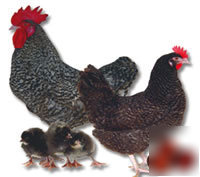Machine Recycling Discussion and Moderated Newsgroup > Components
> Complete Control Circuits
> East
> Used
> 6 cuckoo maran marans eggs for hatching your own chicks
6 cuckoo maran marans eggs for hatching your own chicks
Dark, Darker, Darkest Brown Eggs!
Also Referred To As Chocolate Eggers
This is a hard-to-find heirloom breed that produces a very dark brown egg with a rich yellow (nearly orange) yolk.
Cuckoo eggs are very large and, like all of the Marans breeds, tend to be darkest at the beginning of the laying cycle. Although they get progressively lighter as time goes on, they remain dark brown throughout the laying season, much darker than any other chicken.
This breed originated in France in the town of Marans and is best known for its dark mahogany colored eggs. It is a fast grower and does well in damp areas. The original French birds have feathered legs, but this characteristic has been bred out of the British and many American lines. The males are lighter in color than females (see photos). It is possible to color sex them even as chicks with pretty good accuracy.
My hens have several Cuckoo Maran roosters from which to choose as a boyfriend every day. This makes for an excellent fertility rate. In fact, my broody hen consistently sits large clutches with a 98% hatch rate. The indications are good that these eggs should be just great for hatching out your own flock of Cuckoo Marans.
My flock is a mixture of both British and French strains of Cuckoo Marans, with a good percentage of the chicks having feathered legs.This has no bearing on the colour of the eggs, however.
In France, marans are allowed to have feathered legs when shown, but in the UK this is considered a fault. I am unaware of what the rules are in the US. As few are shown, it is not a matter of life or death; the main importance is on the egg colour. I do not show my chickens, so it matters not at all to me.
I do not wash my eggs before I send them. If you want them washed, that is up to you. Some people wash eggs before setting them, some don't. I do not. I believe washing substantially lowers the chances of successful hatching. Just my opinion, however.
I will pack super carefully. I used to use bubble pack, packing peanuts, and egg crates, wrapping each egg individually, but I was getting a lot of breakage. Lately, I've been double-wrapping each egg and packing them firmly in a massive bed of shredded paper, which has had better success. If you have a special way you want your eggs packed, let me know.
This is as far as my control extends, and from then on, it is up to others to make sure your eggs arrive safely. This is where things can go wrong!
There is the possibility that they will get thrown around by postal workers during loading and unloading. Even if the shells aren't broken, the sensitive embryo can be damaged. They can also be subjected to temperature extremes; either too hot or too cold can spell disaster. Too hot, and the embryo starts to grow or dies if temps are really high. Too cold and the embryo freezes. Hatching eggs should be kept at a cool temperature of between 45-60 degrees. If you live in an area that has excessively high or low daytime temps, you might consider making arrangements with the Post Office so they don't sit outside. Even with all the extra precautions, there is still no guarantee.
The last factor is your incubator. Whether you use a broody bird or an artificial means of incubating your eggs, things can always go wrong here. Power interruptions or failures. Temperature and humidity settings go crazy. The turner stops turning. The list is endless, and Murphy's Law is always in effect.

